Heavy strike aircraft Lockheed AC-130A
The purpose of AC-130 was as follows: patrolling and disrupting enemy communications; direct air support of troops on the battlefield; air strikes on pre-designated ground targets; ensuring the defense of strategically important facilities and bases of their troops. The works on the ganship program started in the USA in 1965. The US Air Force wanted to have at its disposal an aircraft with the strongest weaponry, increased flight duration, take-off weight and cruising speed.
In this regard, the military transport aircraft C-130 Hercules was chosen as the most suitable platform for creating a new aircraft. At the same time, the Air Force allocated to the military a very battered during the operation of the C-130 (serial number 54-1626) release in 1954. Today this car can be seen at the National Museum aviation USA located in Dayton. Initially, the aircraft was armed with four machine-gun modules MXU-470, specially created as part of this project and four six-barreled 20-mm cannons "Volcano". The aircraft housed an analog computer, night vision system, radar, similar to that installed on F-104 fighters, and powerful searchlights.
Flight tests began in the summer of 1967, at the Wright-Patterson and Eglin aviation bases. Later, one of the test participants said with surprise: “All the existing fire control subsystems work, and sometimes they even work together.” As a result, by September of the same year, the military could bring the car to a more or less decent level, after which the 20 of September 1967 was transferred to Nyatrang airbase for 90-day testing. The first combat flight of the aircraft made 27 September. At the same time, until November 9, “Vulcan Express” (this is how the crew itself nicknamed the plane, although later another name Specter (from the English. Ghost, ghost, phantom), which became common for all AC-130 model aircraft), the plane made several combat missions on support for US ground forces. However, he had to pass his main exam on the night of November 9, when the plane took off to hunt for trucks following the Ho Chi Minh trail. Almost immediately after reaching the specified area above the path, the operator of the infrared night vision system found 6 vehicles, which were turned into burning ruins in 15 minutes. All of them were broken by sighting artillery fire from the sky.
The successful start of the combat use of the new aircraft contributed to the decision to build a new heavily armed artillery aircraft based on the C-130 transporter. At the same time, the command of the US Air Force regretted transferring new machines to install weapons on them. As a result, the Ling-Temko-Vout plant, at which the machines were being modernized, received 7 previously operated JC-130А. All the transferred aircraft were problematic and were far from in perfect technical condition. So one of the received JC-130 with serial number 53-3129 was the first serial "Hercules", which was transferred to 1957 in the US Air Force. Already in the third flight on this plane there was a fire. The crew managed to land the plane, but it had to completely change the wing. These are the military planes handed over for conversion to ganships. In 1960, the plane on which the fire had previously occurred was converted to JC-130A, which was used to test guided missile radars. In the AU-130, it was upgraded in 1970 year. Out of respect for the venerable veteran, the plane was called “Lady Fest”, although it was not the first AC-130 ganship. This aircraft served as a military for a very long time. It was finally written off only in September 1995, the last of all aircraft modifications AC-130A.
The first fully converted aircraft from the JC-130 was transferred to the US Air Force in the summer of 1968. The car went to Vietnam in 6 months. The aircraft had the same weapons as the Vulcan Express, but instead of a primitive infrared night vision system, it had a more advanced AN / AAD-4 system, as well as a more advanced computer fire control system. Officially, the aircraft received the designation AC-130A Specter. Three more aircraft in the AC-130A version were sent to Vietnam before the end of 1968. The remaining three cars remained in the states, based at Eglin airbase. On these machines held training crews who were preparing for hostilities. In May, 1969, the aircraft were sent to Ubon air base in Thailand. From this base cars made combat missions to Vietnam. At the same time, all 8 airplanes АС-130А, which as a result took part in combat operations against Viet Cong, differed from each other like the most real battleships. They had differences in the interior and exterior, which very often became a problem during their maintenance.
The ninth AC-130A was transferred from the factory to the Wright-Patterson air base. It conducted tests to develop a more sophisticated heavily armed aircraft in the framework of the Surprise Package. On this machine, two Vulkan 20 units were replaced with single-barrel Bnofors 40-mm guns, and the aircraft’s on-board equipment included a laser range-finder and an AN / ASQ-145 television system. The analog computer on this plane was replaced with a more modern digital version. In addition, according to another Pave Pronto program, the US Air Force signed an agreement for the re-equipment of another 9 C-130 transport aircraft. All these vehicles were to receive the Black Crow system, which was supposed to detect the operation of the engines of the automobiles, the enemy’s air defense system and the EW equipment. Of the eight aircraft AC-130A, which were originally sent to Vietnam, survived 6 machines. They were sent back to the USA in order to retool as part of the Pave Pronto program.
The main objective of these aircraft was the night hunt for ground transportation, which flew on the so-called Ho Chi Minh trail. All the ganships were consolidated into a special purpose squadron 16, which was located at the Ubon air base. These aircraft began regular flights in 1969-1970. And the most successful in terms of performance were 1970 and 1971 years. During this time period, the enemy’s 12 741 vehicle was damaged and broken. However, this figure is very conditional, since more than 5 thousands of units of automotive equipment were attributed to their combat merits by the crews of other American planes, who also patrolled the trail. The damage inflicted on the enemy was assessed based on the combat experience gained. In particular, it was found that the car is destroyed if it caught fire or received a direct hit by the Bofors 40-mm projectile. Damage to the car occurred after a 20-mm projectile hit it or if the 40-mm projectile was torn from it within a radius of three meters.
At the same time, AC-130 aircraft made combat missions only during the dry season. In the rainy season, the roads in Vietnam were eroded and the transport links between South Vietnam and Laos stopped. In addition, each aircraft AC-130 could cruise over the track for about four hours. The detected targets were processed by the Black Crow system, the location was determined using infrared and TV systems on board, after which the crew tried to aim as soon as possible. Fire to kill could be conducted both fully automatically and manually. At the same time throughout the use of the definition of damage caused to the machines of the enemy, still was a problem. Some trucks, after hitting 20-mm aircraft shells fired from AC-130А aircraft, could immediately start and move on. Very often, Lockheed AC-130А aircraft flew out on combat missions accompanied by an RC-130S aircraft, on which 28 searchlights were mounted. This bunch carried out patrols at night.
During the time the Vietnam War lasted, the crews of the gunships got the hand to avoid fire damage from ground-based anti-aircraft installations, but such planes could not escape from ground-to-air missiles, they lacked maneuverability. After the appearance of this weapons it became clear that it was time to take the Spectra out of the combat zone. However, daily successes in the form of the destruction or damage to dozens of enemy trucks forced the US Air Force leadership not to remove combat vehicles from the theater of operations. So only in the first decade of 1971, did the pilots report on the destruction of 2,5 thousands of enemy trucks and damage to the same number of vehicles. However, sometimes the ganships were met with a tough response from the enemy. So 31 March and 1 April 1971, the Americans lost two cars, two expensive aircraft were hit by anti-aircraft guns, equipped with a homing system on the target.
After that, AC-130A Specter aircraft began to be flown to areas in which the concentration of enemy air defenses was less significant. They were even used to fight the Vietnamese tanks during the protection of An Locke. But here these aerial low-speed boats could not prove themselves properly, having met good resistance. At this point, the Armament-2 MANPADS appeared on the arsenal of the Viet Cong. Thanks to the use of these systems, the Communists managed to knock out three AC-130 aircraft. But, despite the growing danger of use, the Americans used their ganships until the end of the war. After the war, 10 AC-130A aircraft returned to the United States, which went to Halbart Field air base. At the same time, 52 people who were part of the ganship crews died during the hostilities.
The AC-130 was notable for its unique layout. All of his gun-gun armament was concentrated on the left side of the machine (by flight) perpendicular to the axis of the aircraft. For this reason, for the combat use of aircraft on ground targets, he had to constantly make a left turn around a given area, circling over the target. At the same time, the weapons compartment in the cargo compartment was separated from the crew cabin by a special smoke screen, and the loaders worked on the plane in special masks.
Armament aircraft continuously improved. As a result, starting with the AC-130H modification, even an 105-mm howitzer appeared on board. The planes in this version were equipped with two six-barrel 20-mm Vulcan automatic cannons (3000 projectile ammunition, maximum rate of fire - 6000 rds / min, normal - 2500 rds / min), one 40-mm automatic gun Bofors L60 (256-MINNAS 120) maximum rate of fire 105 shots / min) and lightweight 102-mm howitzer M100 manual loading (ammunition 40 shells). Due to the airframe vibration shooting, the rate of fire of the 100-mm gun should not exceed 105 rds / min. According to information from open sources, the 102-mm howitzer M40 is a modernized version of a standard military howitzer. However, it was greatly facilitated, and its trunk was shortened. In addition, she acquired a special gun carriage. The howitzer received a hydraulic control system that allows the barrel to be easily rotated within 20 ° in elevation and 3 ° in azimuth. The calculation of such a howitzer consists of 130-x people. In addition, the aircraft was able to use guided bombs with a laser homing head. On the first models, such as the AC-7,62A, XNUMX-mm six-barreled Minigun machine guns were also installed.
The AC-130 aircraft personal protection system includes: equipment warning the crew about the exposure of an enemy radar machine; hanging containers with IR traps and dipole reflectors; active jamming stations. The composition of the on-board electronic warfare equipment includes the Black Brow radio and electronic reconnaissance equipment, which is used to reconnoiter the enemy’s electronic equipment, search for and subsequently recognize their objects equipped with miniature radio beacons. In order to increase the duration and range of the flight, the aircraft AC-130 was equipped with a system that allows its refueling in the air.
Currently, all the weapons installed on board the AU-130 aircraft are controlled by a computerized search and sight system, which includes thermal and television sights, as well as a radar. The presence of such equipment allows you to effectively use the weapons on board in all weather conditions, day and night. In addition, a synthetic aperture radar appeared on the AC-130U modification, which allows detecting targets at long distances. Unlike the AC-130H modification (in service with the 1973 of the year), the fire control system on the AC-130U (in service with the 1995 of the year) allows you to fire two targets simultaneously. In addition, the aircraft AC-130U able to take on board twice as much ammunition than the previous version. As part of the navigation complex ganship there is an inertial navigation system, which is integrated with the receiver of signals of a satellite navigation system. The aircraft’s crew consists of an 13 man and includes 5 officers (two pilots, an operator of onboard artillery systems, an EW operator and a navigator), and also 8 privates (flight engineer, IR equipment operator, TV camera operator, loader, and 4 arrow ).
AC-130A flight performance:
Overall dimensions: length - 29,79 m, height - 11,66 m, wing span - 40,41 m, wing area - 162,12 m2.
Empty weight - 26 911 kg.
Maximum take-off weight - 56 336 kg.
Fuel capacity - 20520 liters.
The power plant - 4TVD Allison T-56-A-11, HP power 4х4050
The maximum flight speed is 580 km / h.
Cruising flight speed - 333 km / h.
Fighting speed - 270 km / h.
Practical range - 1700 km.
Combat radius of action - 900 km.
Combat altitude - 1070-2450 m.
Practical ceiling - 10 060 m.
Crew - 11 man.
Armament: 4 six-barrel 7,62-mm machine gun GAU-2 / A, and 4 six-barrel 20-mm gun M61 Vulcan.
AC-130A at the Dayton Museum
Information sources:
http://www.airwar.ru/enc/attack/ac130.html
http://avia.pro/blog/lockheed-ac-130
http://worldweapon.ru/sam/ac130n.php
http://igor113.livejournal.com/364320.html (фото)
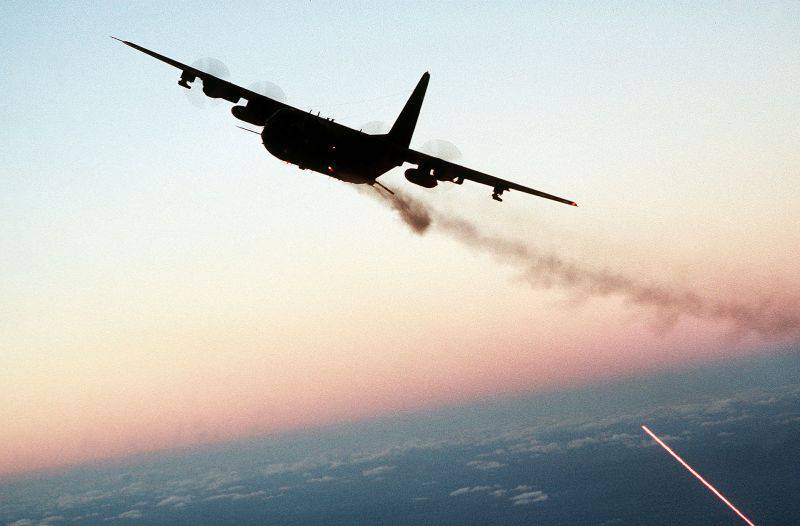
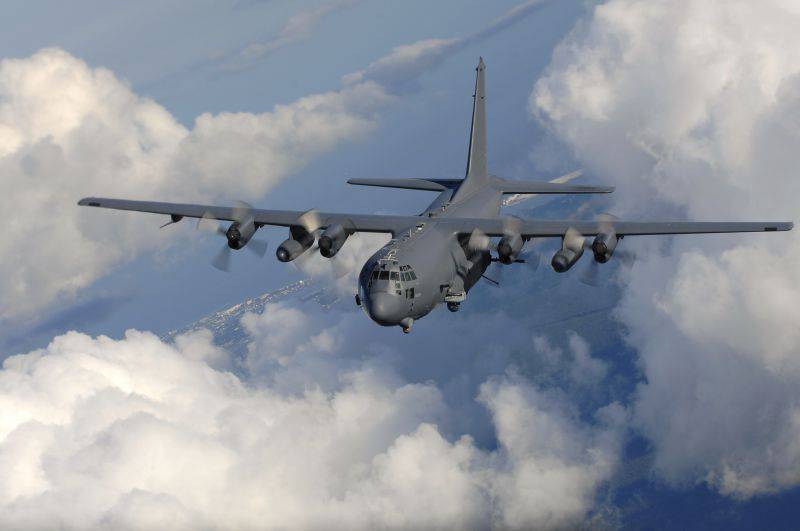
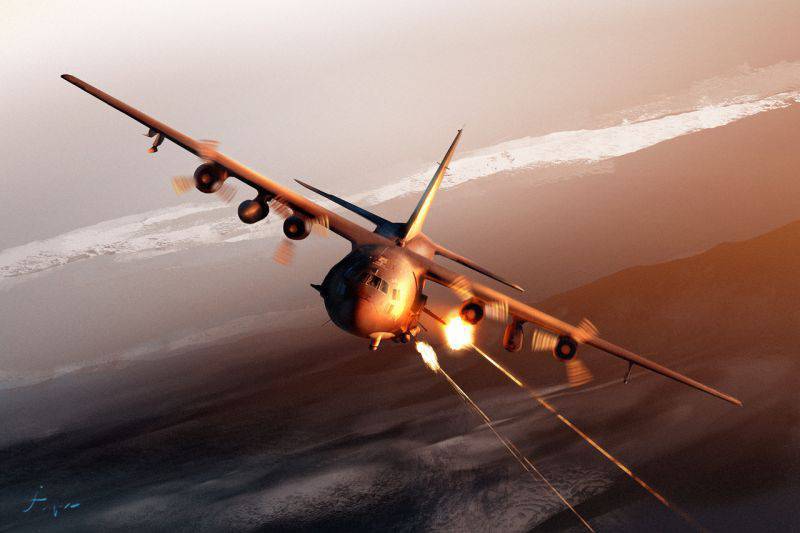
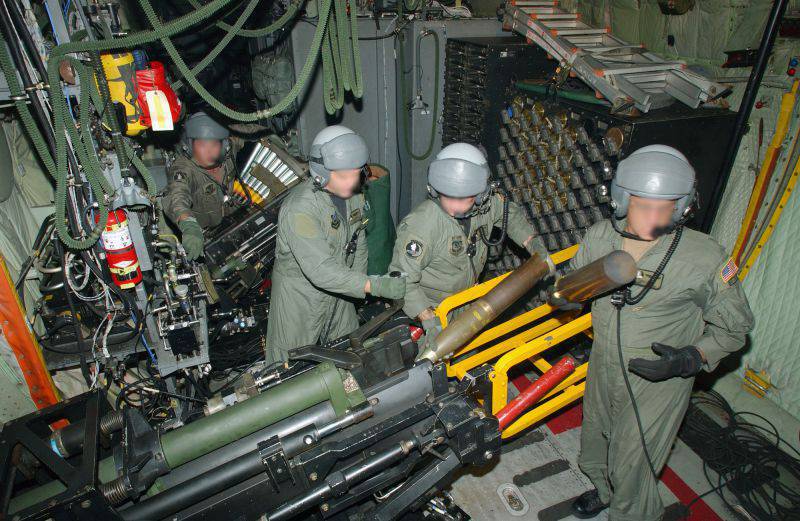
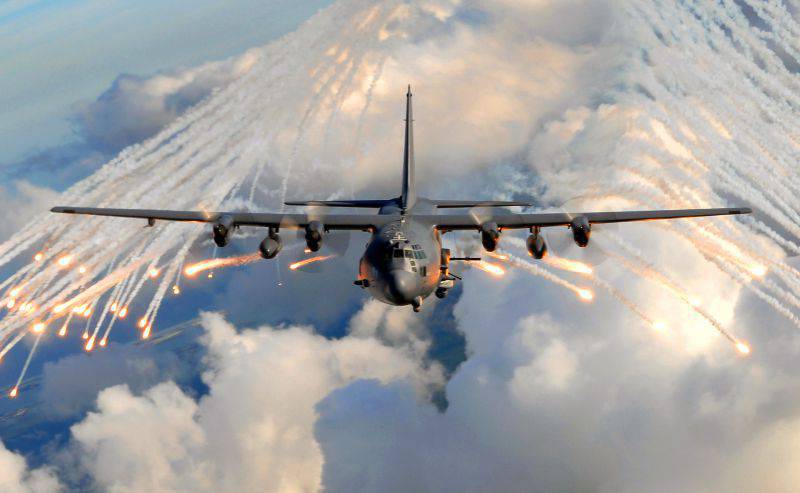
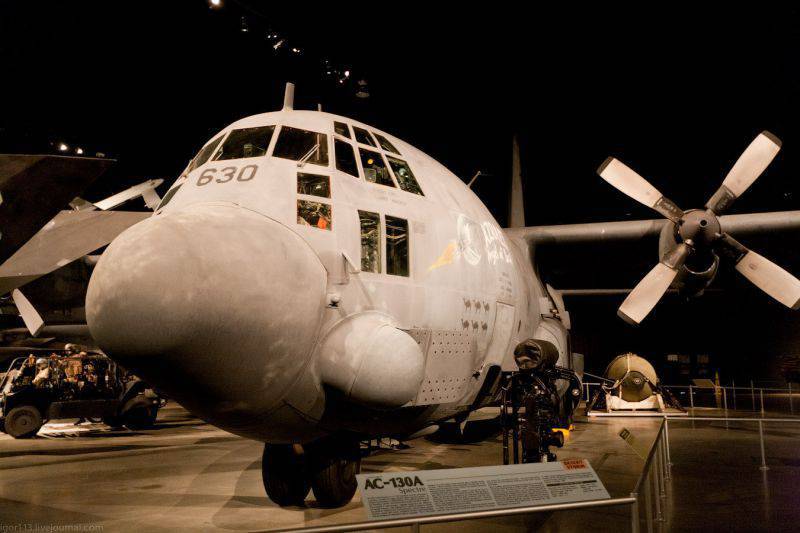
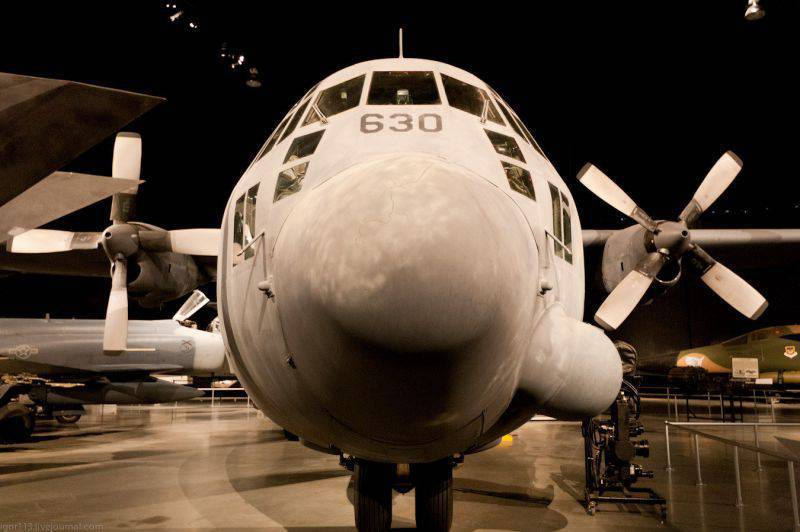
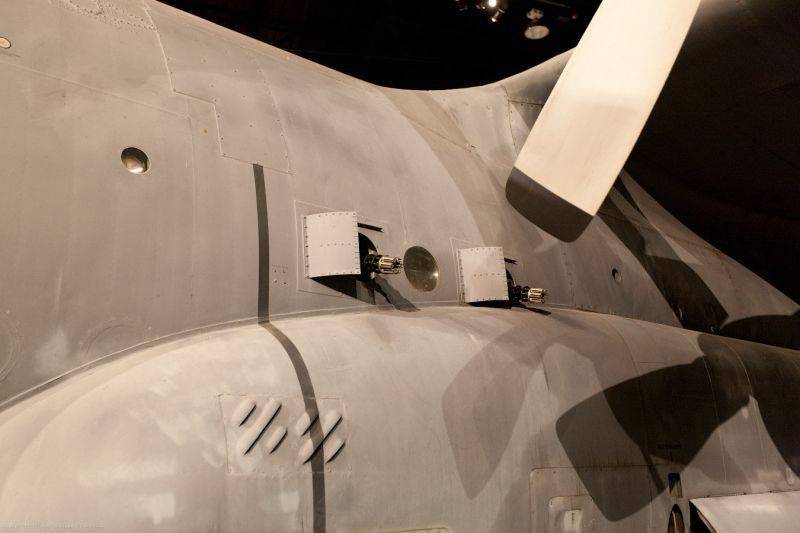
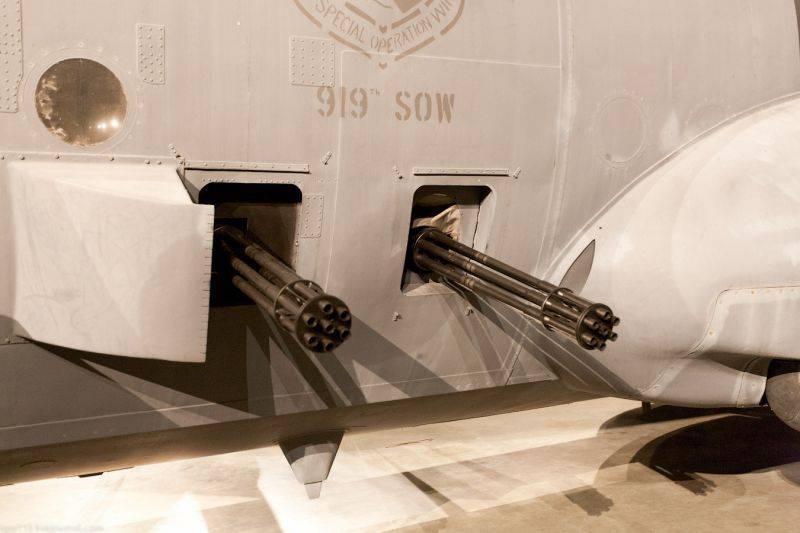
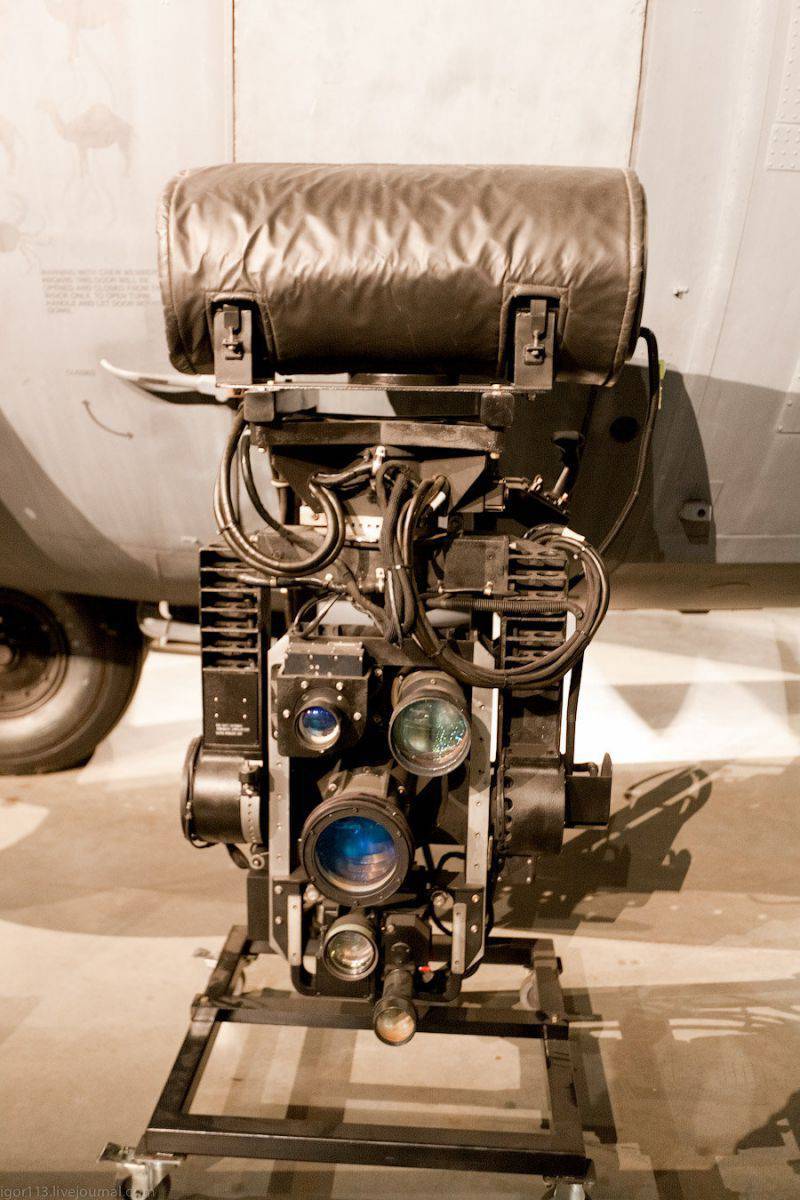
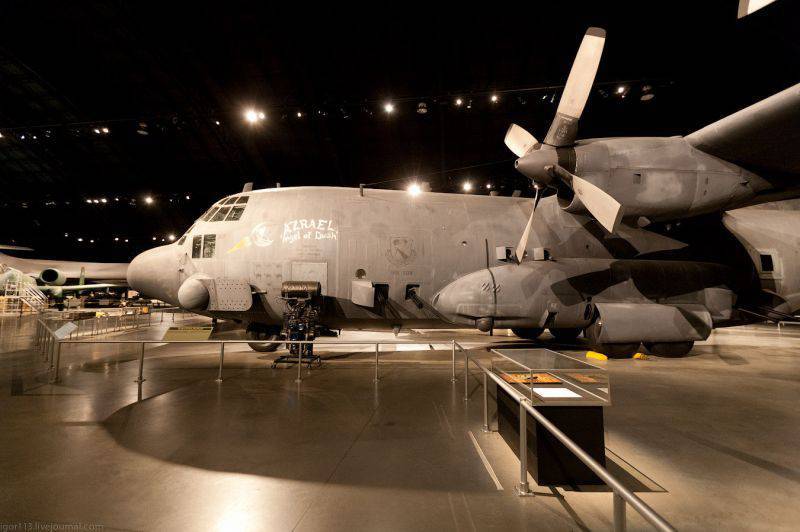
Information